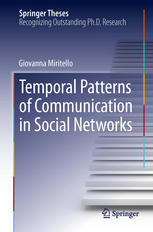

Most ebook files are in PDF format, so you can easily read them using various software such as Foxit Reader or directly on the Google Chrome browser.
Some ebook files are released by publishers in other formats such as .awz, .mobi, .epub, .fb2, etc. You may need to install specific software to read these formats on mobile/PC, such as Calibre.
Please read the tutorial at this link: https://ebookbell.com/faq
We offer FREE conversion to the popular formats you request; however, this may take some time. Therefore, right after payment, please email us, and we will try to provide the service as quickly as possible.
For some exceptional file formats or broken links (if any), please refrain from opening any disputes. Instead, email us first, and we will try to assist within a maximum of 6 hours.
EbookBell Team

4.0
16 reviewsThe main interest of this research has been in understanding and characterizing large networks of human interactions as continuously changing objects. In fact, although many real social networks are dynamic networks whose elements and properties continuously change over time, traditional approaches to social network analysis are essentially static, thus neglecting all temporal aspects. Specifically, we have investigated the role that temporal patterns of human interaction play in three main fields of social network analysis and data mining: characterization of time (or attention) allocation in social networks, prediction of link decay/persistence, and information spreading. In order to address this we analyzed large anonymized data sets of phone call communication traces over long periods of time. Access to these observations was granted by Telefonica Research, Spain. The findings that emerge from our research indicate that the observed heterogeneities and correlations of human temporal patterns of interaction significantly affect the traditional view of social networks, shifting from a very steady to a highly complex entity. Since structure and dynamics are tightly coupled, they cannot be disentangled in the analysis and modeling of human behavior, though traditional models seek to do so. Our results impact not only the way in which social network are traditionally characterized, but more importantly also the understanding and modeling phenomena such as group formation, spread of epidemics, and the dissemination of ideas, opinions and information.